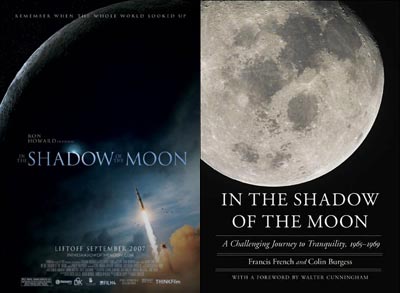Review: Two Shadows on the Moonby Jeff Foust
|
| In his comments Collins brings a mix of both deep reflection on the program—at one point calling the impact it had on the world “ephemeral but wonderful”—and some self-deprecating wit. |
The better known of the two is the feature-length documentary In the Shadow of the Moon, which premiered at the Sundance Film Festival earlier this year and went into limited theatrical release in the US earlier this month. The movie is, in essence, the story of the Apollo program and the missions to the Moon, told by the astronauts who went there. And that is meant literally here: the movie features no narrator, only the voices of the astronauts themselves, woven into historical footage from the Apollo program, and nothing else: no special effects, no reenactments, nothing but the footage of the missions and the voices and faces of those who journeyed to the Moon. It’s that simple combination, skillfully executed by director David Sington, that makes the film that powerful.
Ten Apollo astronauts participated in the film: Buzz Aldrin, Alan Bean, Eugene Cernan, Mike Collins, Charlie Duke, Jim Lovell, Edgar Mitchell, Harrison Schmitt, Dave Scott, and John Young. (A notable, but hardly surprising, omission is the publicity-shy Neil Armstrong.) All appear in the movie against a plain lunar-gray backdrop, with the cameras sometimes zoomed so tight on their faces that the tops of their heads are cropped off the screen. All get a chance to describe the Apollo program and their reflections on their missions, but if there’s one person who stands out, it’s Collins, the Apollo 11 command module pilot. In his comments Collins brings a mix of both deep reflection on the program—at one point calling the impact it had on the world “ephemeral but wonderful”—and some self-deprecating wit: he recalls arriving at the launch pad with Aldrin and Armstrong shortly before the launch of Apollo 11 and noticing that, unlike all the previous tests they had done there, there were virtually no other personnel around. Did they know something, he wondered to himself, half-jokingly, that he didn’t?
Lost in the, well, shadow of the film In the Shadow of the Moon is the book of the same title, by space historians Francis French and Colin Burgess. The book is a continuation of Into That Silent Sea, the history of the early space age published earlier this year (see “Review: Into That Silent Sea”, The Space Review, June 25, 2007). In the Shadow of the Moon picks up where the earlier book left off, diving into the Gemini and Apollo programs in the US and the early Soyuz program in the USSR, culminating with the Apollo 11 landing on the Moon.
The book takes a fairly standard chronological approach to the history of manned space programs in the two countries, mixing discussions of the missions with biographies of the astronauts and cosmonauts who flew them. (This is somewhat different than Into That Silent Sea, where each chapter was effectively a mini-biography.) There’s a wealth of information and insights about the people and missions in each chapter, at least for those who haven’t immersed themselves in space history. This book also relies more on interviews with the astronauts themselves, and less on interviews with others involved with the programs, outside of a few special cases like the Apollo 1 accident.
| Is one In the Shadow of the Moon better than the other? Not necessarily. |
One interesting aspect of the book In the Shadow of the Moon is that the actual Apollo 11 lunar landing—which is where the book ends, save for a brief epilogue—is almost anticlimactic. The last part of the book, which deals with the Apollo 10 and 11 missions, feels a little rushed compared to the previous chapters, in part, perhaps, because we have already been introduced to the crews of those missions from their earlier Gemini flights. The Soviet program also gets considerably less coverage in the book than the American program: while the authors do cover the fatal Soyuz 1 flight and the more successful early Soyuz missions that followed, there is little in the book about the Soviet efforts in the late 1960s to try and beat the US to the Moon with its powerful but ultimately flawed N-1 rocket.
Is one In the Shadow of the Moon better than the other? Not necessarily. The book goes into far more detail than one could ever hope to cram into a film, from biographies to mission descriptions to even debunking a few rumors. The film, though, provides a far stronger, visceral emotional impact than the book: it is hard, watching the movie, to not get a lump in your throat at one point or another, particularly when Aldrin, Collins, and Duke (who was capcom in mission control) describe the Apollo 11 landing. That effect is hard to discount, but regardless, neither the book In the Shadow of the Moon nor the movie In the Shadow of the Moon should have to worry about living in the shadow of the other.
